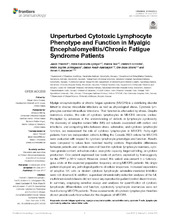| dc.contributor.author | Theorell, Jakob | en_US |
| dc.contributor.author | Bileviciute-Ljungar, Indre | en_US |
| dc.contributor.author | Tesi, Bianca | en_US |
| dc.contributor.author | Schlums, Heinrich | en_US |
| dc.contributor.author | Johnsgaard, Mette Sophie | en_US |
| dc.contributor.author | Asadi-Azarbaijani, Babak | en_US |
| dc.contributor.author | Strand, Elin Bolle | en_US |
| dc.contributor.author | Bryceson, Yenan | en_US |
| dc.date.accessioned | 2018-01-04T14:27:14Z | |
| dc.date.available | 2018-01-04T14:27:14Z | |
| dc.date.issued | 2017-06-26 | |
| dc.Published | Theorell J, Bileviciute-Ljungar, Tesi B, Schlums H, Johnsgaard, Asadi-Azarbaijani BAA, Strand EB, Bryceson Y. Unperturbed cytotoxic lymphocyte phenotype and function in myalgic encephalomyelitis/chronic fatigue syndrome patients. Frontiers in Immunology. 2017;8:723 | eng |
| dc.identifier.issn | 1664-3224 | |
| dc.identifier.uri | https://hdl.handle.net/1956/17129 | |
| dc.description.abstract | Myalgic encephalomyelitis or chronic fatigue syndrome (ME/CFS) is a debilitating disorder linked to diverse intracellular infections as well as physiological stress. Cytotoxic lymphocytes combat intracellular infections. Their function is attenuated by stress. Despite numerous studies, the role of cytotoxic lymphocytes in ME/CFS remains unclear. Prompted by advances in the understanding of defects in lymphocyte cytotoxicity, the discovery of adaptive natural killer (NK) cell subsets associated with certain viral infections, and compelling links between stress, adrenaline, and cytotoxic lymphocyte function, we reassessed the role of cytotoxic lymphocytes in ME/CFS. Forty-eight patients from two independent cohorts fulfilling the Canada 2003 criteria for ME/CFS were evaluated with respect to cytotoxic lymphocyte phenotype and function. Results were compared to values from matched healthy controls. Reproducible differences between patients and controls were not found in cytotoxic lymphocyte numbers, cytotoxic granule content, activation status, exocytotic capacity, target cell killing, or cytokine production. One patient expressed low levels of perforin, explained by homozygosity for the PRF1 p.A91V variant. However, overall, this variant was present in a heterozygous state at the expected population frequency among ME/CFS patients. No single patient displayed any pathological patterns of cellular responses. Increased expansions of adaptive NK cells or deviant cytotoxic lymphocyte adrenaline-mediated inhibition were not observed. In addition, supervised dimensionality reduction analyses of the full, multidimensional datasets did not reveal any reproducible patient/control discriminators. In summary, employing sensitive assays and analyses for quantification of cytotoxic lymphocyte differentiation and function, cytotoxicity lymphocyte aberrances were not found among ME/CFS patients. These assessments of cytotoxic lymphocytes therefore do not provide useful biomarkers for the diagnosis of ME/CFS. | en_US |
| dc.language.iso | eng | eng |
| dc.publisher | Frontiers | eng |
| dc.rights | Attribution CC BY | eng |
| dc.rights.uri | http://creativecommons.org/licenses/by/4.0 | eng |
| dc.subject | chronic fatigue syndrome | eng |
| dc.subject | myalgic encephalomyelitis | eng |
| dc.subject | natural killer cells | eng |
| dc.subject | cytotoxic T cells | eng |
| dc.subject | lymphocyte cytotoxicity | eng |
| dc.subject | adaptive natural killer cells | eng |
| dc.title | Unperturbed cytotoxic lymphocyte phenotype and function in myalgic encephalomyelitis/chronic fatigue syndrome patients | en_US |
| dc.type | Peer reviewed | |
| dc.type | Journal article | |
| dc.date.updated | 2017-11-02T12:27:23Z | |
| dc.description.version | publishedVersion | en_US |
| dc.rights.holder | Copyright 2017 The Author(s) | |
| dc.identifier.doi | https://doi.org/10.3389/fimmu.2017.00723 | |
| dc.identifier.cristin | 1477022 | |
| dc.source.journal | Frontiers in Immunology | |

